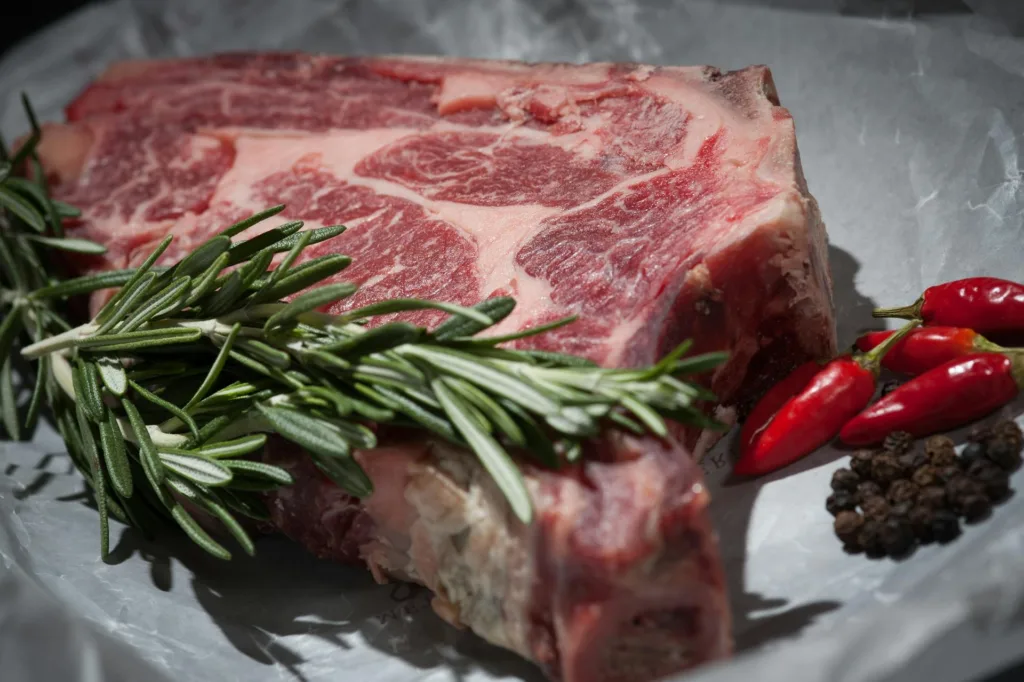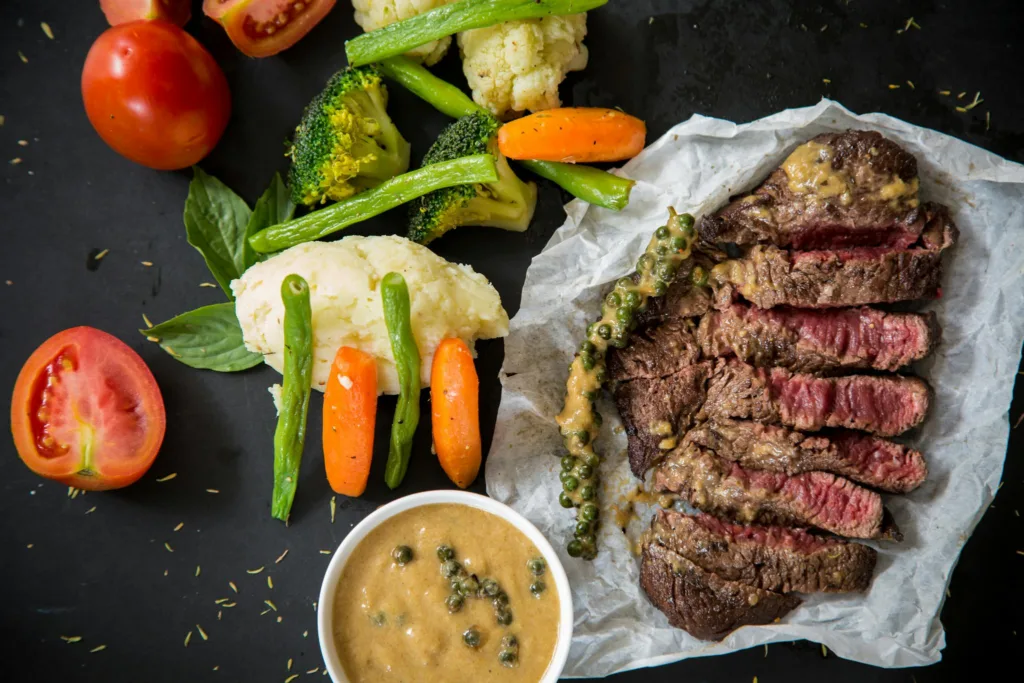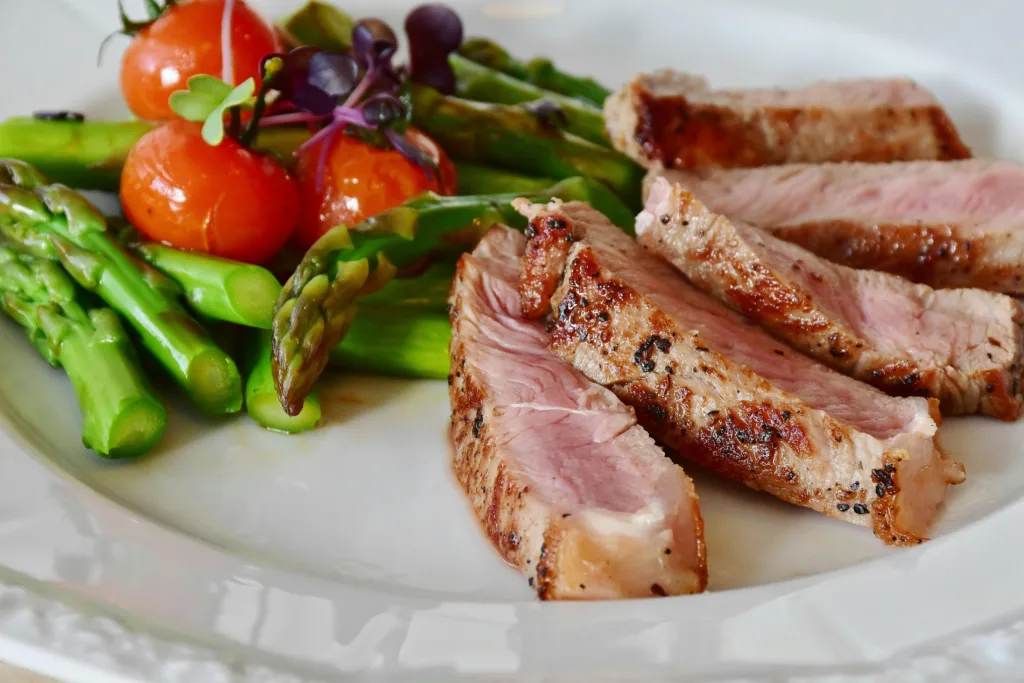If you’ve ever tried eating only animal-based foods for more than a few days, you know it’s not as effortless as it sounds. Sure, the carnivore diet cuts out a ton of decision fatigue: no carbs, no labels to decode, no endless food groups to rotate but it can still feel repetitive, hard to organize, and easy to fall off without a plan. That’s where we’ve found structure matters most: having your meals mapped out week by week can turn “just meat” into something that actually works for 30 days straight.
At ReciMe, we built our app to help people stick with whatever food approach works for them even if it’s zero carbs and steak for breakfast. You can save recipes from anywhere, drop them into your meal planner, and get a grocery list sorted by aisle in seconds. Trying carnivore? We’ll help you track what you’ve already cooked, adjust meals on the fly, and make sure you’re not standing in the fridge wondering if bacon and eggs again is a valid dinner (it is). Simple, flexible, and built for how real people actually eat. Download ReciMe today and make diet meal planning feel easy again.

Download for free from the App Store on iPhone and iPad
So Wait – You’re Only Eating Meat?
Pretty much. The carnivore diet cuts out everything except animal-based foods – meat, fish, eggs, and maybe a bit of cheese if you tolerate dairy. No fruits, no veggies, no grains, no sugar. It’s the opposite of trendy “balanced plate” eating, and that’s kind of the point. By removing all carbs, your body shifts into burning fat for fuel instead of glucose. Some people say they feel sharper, more energized, and way less bloated. Others? Not so much. The first week can feel rough – think headaches, fatigue, and cravings while your system adjusts.
Is it safe to do it for 30 days? That really depends on your body. For many, it works as a short-term reset especially for folks dealing with inflammation, energy crashes, or digestion issues. But it’s not a one-size-fits-all solution. You’re skipping a lot of nutrients found in plants (like fiber and vitamin C), and some people might run into issues with digestion or nutrient gaps. If you’ve got health stuff going on or you’re just unsure it’s always worth checking in with your doctor before diving in. Thirty days of meat-only eating isn’t necessarily dangerous, but it’s definitely not a casual change either.

30-Day Carnivore Meal Plan: Day-by-Day Breakdown
We get it. You want the whole plan mapped out. No guesswork, no “what do I eat today” panic at 7 a.m. Just a clear 30-day layout that keeps your meals simple, satisfying, and easy to follow. Here’s your day-by-day guide, loosely based on weekly rhythm but broken down clearly by day. Tweak it based on what you like and what’s in your fridge.
Day 1
Ease into things with buttery scrambled eggs and crispy bacon in the morning. At lunch, go for juicy ground beef patties cooked in tallow – no need for extras. Wrap up with a well-seared ribeye steak for dinner. Salt generously, rest before slicing, and you’re good.
Day 2
Start your day with a rich omelet made from yolks and a splash of cream. For lunch, grill chicken thighs with skin-on until golden and crisp. Dinner is simple and filling: pork chops pan-fried in ghee, served hot and unadorned.
Day 3
Hard-boiled eggs paired with thin-sliced steak make for an easy and satisfying breakfast. At lunch, sear a piece of salmon with sea salt. Dinner? A warm mug of bone broth with shredded roast beef stirred in.
Day 4
Go classic with bacon and sunny-side eggs for breakfast. For lunch, grill lamb chops until tender. Bake trout for dinner, seasoned with just salt.
Day 5
Feta-stuffed omelet in the morning brings in some tangy flavor if dairy works for you. Then go for turkey burgers with cheddar at lunch. End the day with pork belly slices roasted until crisp and golden.
Day 6
Sauté chicken liver in butter for a nutrient-packed breakfast. Lunch is a tuna plate with hard-boiled eggs – light but high in protein. Dinner is duck leg confit with crispy skin that tastes better than takeout.
Day 7
Kick off with a cheesy omelet loaded with bacon bits. For lunch, enjoy a herb-crusted flat iron steak. Dinner is grilled salmon with the skin left on for that satisfying crunch.
Day 8
Soft-boiled eggs with pancetta bring a slightly fancier feel to breakfast. Lunch is shredded beef cooked low and slow in broth. Dinner features chicken thighs crisped in tallow until the edges sizzle.
Day 9
Keep it comforting with bacon and scrambled eggs. Grill a thick bison burger for lunch and top with aged cheese. At dinner, roast sardines until the skin bubbles.
Day 10
Heat leftover steak strips in butter for a quick breakfast. For lunch, lamb ribs roasted with sea salt make a flavorful centerpiece. Dinner is a bowl of tender short ribs simmered in broth until falling apart.
Day 11
Try turkey sausage with a side of fried eggs in the morning. For lunch, bake or air-fry chicken wings until the skin is perfectly crisp. Dinner is a pan-seared duck breast, medium rare and rich.
Day 12
Bacon-wrapped egg bites are perfect for a no-fuss breakfast. Stir-fry sliced ribeye leftovers for a fast lunch. Dinner is a slow-roasted pork shoulder cooked low until pull-apart tender.
Day 13
Whip up a frittata with leftover meat and cheese to start the day. Grill salmon or trout for lunch, keeping the seasoning minimal. Lamb loin chops for dinner – salted, seared, and served with nothing else.
Day 14
Begin with a cheddar omelet and black coffee (if you’re keeping it). Have ground beef patties for lunch – seasoned, seared, and stacked. Finish with roasted bone marrow, sprinkled with flaky salt.
Day 15
Keep it classic with scrambled eggs and bacon. For lunch, bake chicken thighs until the skin crackles. Dinner is a New York strip steak – simple, reliable, and always satisfying.
Day 16
Make a creamy omelet with a bit of leftover ground beef stirred in. Tuna and boiled eggs make for an easy high-protein lunch. Crisp pork belly slices for dinner until they’re golden and crunchy.
Day 17
Soft-boiled eggs start your day without fuss. Grill a duck breast for lunch, cooked medium rare. End the day with a thick-cut ribeye and plenty of salt.
Day 18
Mix it up with a cheesy frittata for breakfast. Lunch is crispy chicken wings again because they’re worth repeating. Roast lamb ribs until the meat easily pulls from the bone.
Day 19
Bacon and eggs for breakfast, again and somehow still satisfying. For lunch, have a warm bowl of ground beef cooked in tallow. Dinner is a fillet of salmon pan-seared with a touch of ghee.
Day 20
Steak strips fried in butter make a solid start. Lunch is turkey burgers, quick and versatile. Finish with pork chops, lightly seasoned and grilled to your liking.
Day 21
Boil eggs and crisp pancetta for a quick morning bite. Grill sardines or mackerel for lunch. Dinner is short ribs cooked until soft and rich.
Day 22
Start the day with an omelet filled with leftover steak. Lamb chops for lunch are always a win. Grill a bison burger for dinner, maybe topped with a slice of hard cheese.
Day 23
Stick with hard-boiled eggs in the morning. Roast duck at lunch for a rich, savory change of pace. Crisp up chicken thighs for dinner, seasoned simply.
Day 24
Bacon-wrapped egg cups are ideal when you’re short on time. Tuna with hard cheese makes a quick lunch. Dinner? Ribeye, again and you won’t regret it..
Day 25
Start with turkey sausage and eggs. Go in on a roasted pork shoulder for lunch. Dinner is salmon, simple and seared.
Day 26
Steak and fried eggs is the ultimate energy breakfast. Eat lamb ribs at lunch – no sides needed. Bone broth loaded with shredded meat is perfect for dinner.
Day 27
A cheese omelet starts the day (if you’re still okay with dairy). Lunch is crispy chicken wings. Dinner is roasted pork belly with a side of… more pork belly.
Day 28
Scrambled eggs with butter make a soft landing in the morning. For lunch, cook a flat iron steak to medium rare. Dinner is duck confit again, because it’s too good not to repeat.
Day 29
Boil eggs and pan-fry pancetta for a salty combo. Grill bison patties for lunch. Lamb loin chops close out the evening with flavor and fat.
Day 30
Go big. Steak and eggs to start. A salmon bowl for lunch. And for dinner? Your favorite meal from the past month. Pick the one you’d happily eat on repeat.

Benefits You Might Notice in 30 Days
Everyone’s body reacts differently, but after a month of eating nothing but animal-based foods, certain patterns start to show up – some expected, some surprisingly welcome. Here’s what people often report after 30 days of carnivore eating:
- Way fewer cravings: When your meals are all protein and fat, blood sugar stays level. No crashes, no sudden “I need a cookie” moments. You might even forget what cravings feel like.
- More stable energy: Once you’re fat-adapted (usually by week two), energy tends to feel… even. No post-lunch slump, no rollercoaster. Just a steady hum throughout the day.
- Mental clarity: This one sounds fake until it happens. For some, increased reliance on ketones for brain energy during ketosis may contribute to sharper focus and less mental fog. Think: fewer “wait, why did I walk into this room?” moments.
- Simplified everything: Meal planning is faster. Grocery shopping is shorter. Cooking is straight-up easier. You’re not juggling 12 ingredients – you’re cooking meat. Done.
- Better appetite control: Fat and protein keep you full longer. Some folks naturally shift to two meals a day without even trying. You stop snacking because, honestly, you’re just not hungry.
- Possible weight loss: If you’re coming from a standard high-carb diet, shedding a few pounds (especially water weight) isn’t uncommon. The scale might move – but what really matters is how you feel.
Not everyone gets all of these, and some benefits show up later than others. But after 30 days, most people know if the diet is helping – or just making them miss blueberries. Either way, it’s valuable info.
Carnivore Diet Tips for Success
Let’s be real: eating only meat for 30 days sounds simple until your body freaks out on day three and you start dreaming about toast. A little planning (and some honest prep for the weird parts) goes a long way. Here’s what actually helps when you’re doing carnivore without losing your mind.
Don’t skimp on fat.
This isn’t the time for chicken breast and lean steak every day. Your energy’s coming from fat now, not carbs – so go for fatty cuts like ribeye, pork belly, and salmon. If you’re constantly hungry or crashing mid-afternoon, odds are you’re not eating enough fat.
Salt isn’t optional.
Seriously. When you drop carbs, your body loses a ton of water – and with it, sodium. Sprinkle sea salt like you mean it. Some people even add salt to their water or sip bone broth to stay balanced. It’s weird at first but makes a huge difference.
Listen to your appetite (but don’t trust the first few days).
Your hunger signals are going to be weird at the start. One day you’ll want to eat the entire fridge. The next, zero interest in food. That’s normal. Don’t force it – but don’t under-eat either. Once your body adjusts, things usually settle into a groove.
Keep it stupid simple.
You don’t need five new recipes every week. Find a few meals you like and rotate them. If you love scrambled eggs with ground beef, make that your go-to. Nobody gets points for creativity if they’re burned out by week two.
Don’t panic about the keto flu.
Yes, it sucks. You might feel foggy, tired, or just plain cranky the first week. That’s your body switching fuel sources. Stay hydrated, get electrolytes in, and push through. It typically improves within 3 to 14 days, depending on your body’s adaptation to ketosis.
Accept that this isn’t forever.
For most people, carnivores aren’t meant to be a permanent lifestyle. It’s an elimination experiment, a reset, or a way to figure out what your body likes. Go in with curiosity, not perfectionism – and take notes along the way.

Common Challenges and How to Handle Them
Carnivore sounds simple, but it comes with some real friction. Here’s what tends to come up – and how to deal with it without quitting on day five:
- Keto flu: Headaches, fatigue, brain fog. It’s your body adjusting to no carbs. Add salt, drink more water, and ride it out. Usually lasts a few days.
- Getting sick of meat: Eating the same cut every day gets old fast. Rotate proteins – use lamb, fish, organs, chicken, whatever you can find. Change cooking methods if needed.
- Digestion issues: Constipation or loose stools aren’t uncommon. Too much fat or not enough fat can both mess with you. Adjust and see what helps.
- Social meals get tricky: Most people won’t get why you’re doing this. Eat before going out or bring your own food. Skip the explanations if you want.
- Hunger swings: Some days you’ll want five steaks. Other days, zero appetite. That’s normal. Eat when you’re hungry. Don’t force it.
- It gets expensive: Ribeye every night adds up. Use cheaper cuts like ground beef, pork shoulder, or whole chickens. You don’t need premium cuts to do it right.
What Happens After 30 Days?
After 30 days of eating nothing but animal-based foods, you’ve probably got a clearer picture of how your body reacts to it. Maybe you feel lighter, more focused, less bloated – or maybe you’re just really craving a banana. Either way, this is where the experiment part kicks in. Now’s the time to decide if you want to keep going, start reintroducing foods, or shift into a more relaxed version like 80/20 carnivore.
If you’re reintroducing, go slow. Add one thing at a time – maybe eggs if you cut them out, or a handful of berries – and watch how your body responds. Some people stick with full carnivore because it makes them feel great. Others use it as a reset and then transition to something more balanced. There’s no one right way to do this. You’ve already done the hard part. Now it’s about building something that fits your real life.
Conclusion
If you’ve made it this far – or you’re seriously thinking about it – you already know this isn’t your average meal plan. It’s restrictive, a little intense, and definitely not trendy in the kale smoothie sense. But for a lot of people, 30 days of eating only meat is a reset that actually works. No more overthinking what to eat, no label reading, no blood sugar rollercoasters. Just meat, salt, and a plan.
Is it sustainable long term? Maybe. Maybe not. But 30 days is long enough to learn something about your body, your habits, and how much better things can feel when you cut the noise. Keep what worked. Ditch what didn’t. And if you ever want to do it again – well, now you’ve got the plan for it.
FAQ
1. Can I have coffee on the carnivore diet?
Technically no, but most people still drink it – especially during the 30-day version. Just skip the sweeteners and creamers.
2. Do I have to eat organ meats?
No, but they can help with nutrients such as liver, can provide nutrients like iron, vitamin A, and vitamin C, which may help address potential nutrient concerns. If you’re not into liver, don’t force it. Stick to what you’ll actually eat.
3. How much should I eat each day?
As much as you need to feel full. No calorie counting. Just eat when you’re hungry and stop when you’re not.
4. Can I cook with spices and herbs?
Salt and pepper are always fine. Some people use garlic, paprika, or herbs. Up to you. If it helps you stick to the plan, do it.
5. What’s the best meat to eat?
Fatty cuts are key – think ribeye, pork belly, ground beef (80/20), chicken thighs with skin, and salmon. Lean meat will leave you dragging.
6. Is it okay to work out on a carnivore?
Yes. Some people say they have better endurance or faster recovery. Just make sure you’re eating enough, especially fat.
